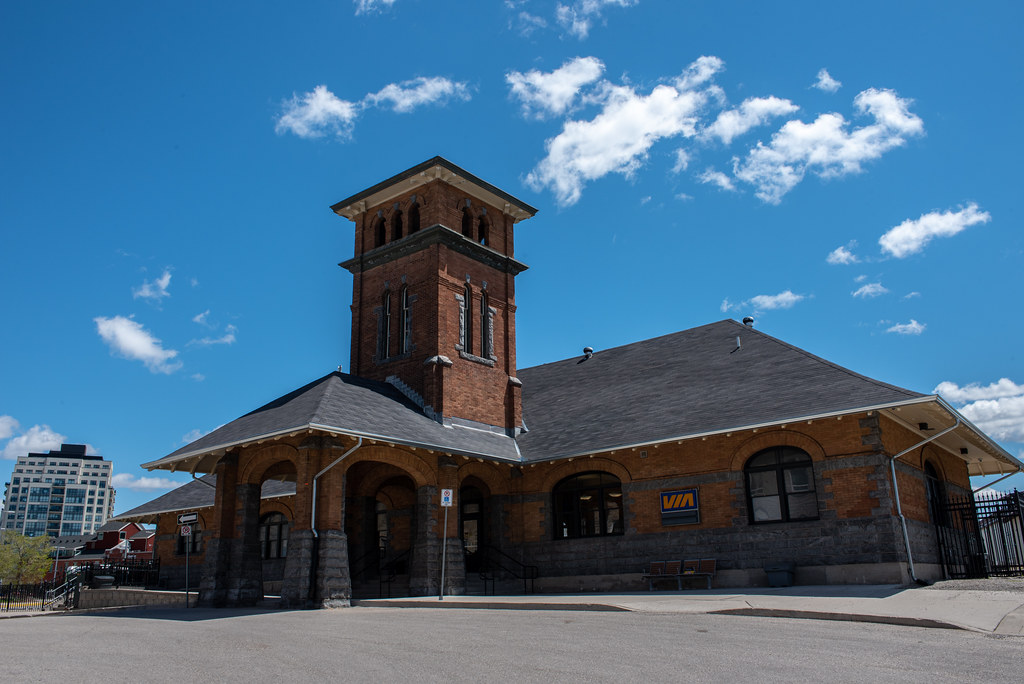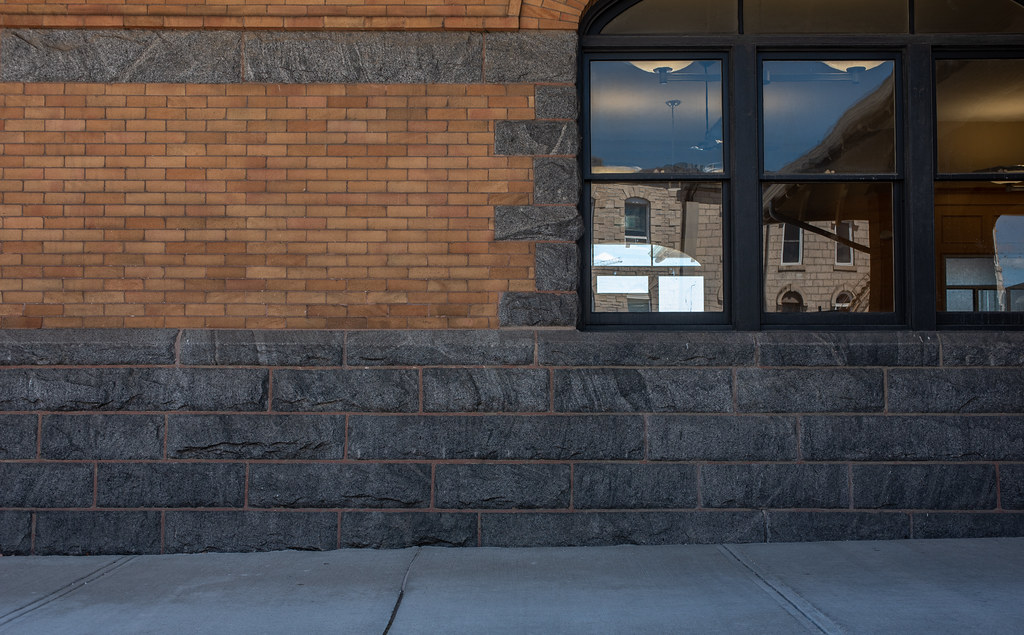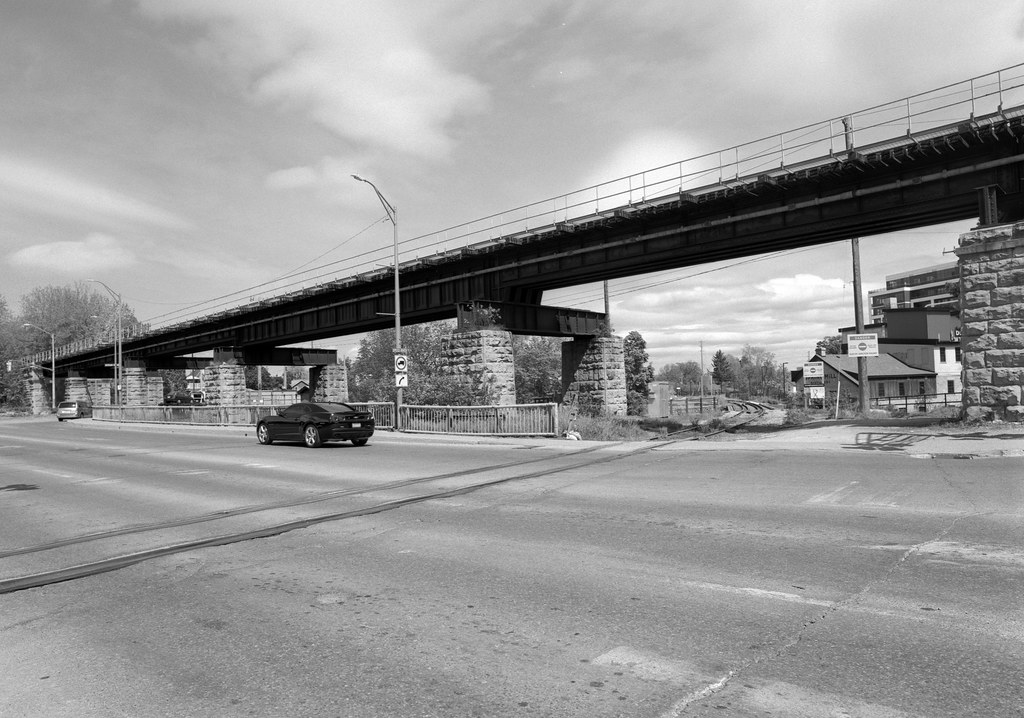The interesting thing about the Guelph Central Station is that I have walked past it many times but have never been drawn to the structure. I’m more likely to walk past it to get a better angle on the armoury or move past towards the old city hall turned courthouse. But Central Station is one of only a few surviving propaganda stations built to instil confidence in the railway operator in the second decade of the new century.

Graflex Crown Graphic – Nikon Nikkor-W 1:5.6/180 – Ilford HP5+ @ ASA-200 – Pyrocat-HD (1+1+100) 9:00 @ 20C
Guelph and the railroad share an interesting relationship since the first Grand Trunk Railway line rolled through 1855. Having acquired the Toronto & Guelph Railway, Grand Trunk recognizing a line from Toronto to Guelph will provide access to the West. The line was immediately extended from Guelph out to Sarnia by way of Stratford and St. Marys. While the railroad offered up several economic perks and the local population enjoyed the easier means of transportation and businesses the capacity to bring in materials and send out goods, there was always a disconnect; Grand Trunk put the right-of-way right through the downtown, cutting through the carefully planned out public green space which had been set aside by John Galt the founder and planner of Guelph. But Grand Trunk usually got its way. The company at least provided a single storey brick station, located where the bus depot sits today. The original 1855 station was designed by Francis Thompson and followed an initial Italianate design with five bays, five large windows. A single waiting room, station master’s office, and baggage room. A separate freight shed was also constructed. The station was then updated in 1870 to a more Second-Empire style roof similar to what happened in Kingston before a fire destroyed much of that station. But by the 1880s, the city and residents were started to feel the pinch. The city had grown, and despite some piece-meal efforts by Grand Trunk, they felt it was unnecessary to build a new station or expand their line. There was also the matter of safety; the level crossing downtown proved a bit of a hazard. It also didn’t help that Grand Trunk was the only major operator for freight. In 1884 the City established the Guelph Junction Railway to build a short line from the city to the Credit Valley (Canadian Pacific) mainline at Campbellville then promptly invited Canadian Pacific to operate on the short line and use the Priory as their station only a few blocks away from the Grand Trunk Station. Now having some clout, the city’s businesses again approached Grand Trunk in 1887 to built a new station. Grand Trunk, still financially unsound, responded by doing minor repair work. When Canadian Pacific began the process of building new stations across its network starting in 1890, Grand Trunk was shaken into action; it also helped that Charles Hayes, now installed as President, saw this as a chance to modernize and unify the entire Grand Trunk Railway starting in 1896. At Guelph, they decided to reuse the old station as a freight office and build a new fitting station for the city in a new location and offered up 5,000$ for a small piece of land, the last public park in the downtown. The city refused the offer, and Grand Trunk went instead to the Federal Government. In 1905 they were granted permission to expropriate the land, and the city had no choice.

Nikon D750 – AF-S Nikkor 28-70mm 1:2.8D
Nikon D750 – AF-S Nikkor 28-70mm 1:2.8D
With the matter of land settled, there remained the matter of design and cost splitting. The city had already launched a lawsuit against Grand Trunk in 1908 for hazards and noise complaints. And the city looked towards the new station at Brantford as a shining example of grand railway architecture. The early 20th Century favoured a blend of Italianate and Romanesque design, which was seen clearly in the 1905 Brantford Station, with towering passenger waiting room and simple baggage space; it was everything that Guelph wanted in their station. The city did win the lawsuit, and Grand Trunk was required to build above grade crossings in a couple of places to ensure a safer downtown. But it also allowed them to reduce the size of the new station. The city was less than pleased when the new plans were published; the look of the Brantford Station was there, but not the size. Construction began that same year; the new station featured a limestone foundation and a buff brick exterior. Ironically, Grand Trunk tore down the old station, using its limestone to form the new station’s foundation. Architectural details included the traditional Romanesque building with a grand Italianate tower and a large porte-cochere. Inside was a general waiting area and a separate lady’s parlour. Spacious baggage and express room were included. A station master’s office, ticket office, and a telegrapher’s bay that jutted out onto the platform finished off the interior. Wooden wainscoting and terrazzo floor with attention to details on the ceiling provided a touch of class. The Guelph Mercury went so far as to describe the new station as handsome, but most in the community saw it as underwhelming. The new station opened with little fanfare in November 1911. Only a handful of Grand Trunk brass was on hand to watch the 1 pm train roll through the new station for the first time. Despite the mixed response, the new above grade rail bridges did improve traffic flow through downtown and reduce accidents and injury. The station continued under Canadian National in 1923 and only saw minor renovations completed, notably the installation of a drop ceiling during the depression to save on heat and elimination of the ladies parlour in favour of washrooms.

Nikon D750 – AF-S Nikkor 28-70mm 1:2.8D
Mamiya m645 – Mamiya-Sekor C 35mm 1:3.5 N (Yellow-12) – Fuji Neopan Acros 100 @ ASA-100 – Adox FX-39 II (1+9) 6:30 @ 20C
When Canadian National eliminated passenger services in 1978, the station was placed under VIA Rail, taking over passenger services across Canada. Being on the main route between Toronto and the United States, the station hosted the International Limited from 1982 to 2004, a jointly operated VIA/Amtrak train running between Toronto and Chicago. GO Transit began operating trains from Toronto to Guelph in 1990, but budget cuts saw the service end after only three years but would see restoration in 2011 and Extention to Kitchener. In 1992 the station received heritage status under the Federal Heritage Railway Station Protection Act. Since the 21st Century, the Station has become a major transit hub in downtown Guelph, a focal point for GO Services (bus and train), VIA Trains, and local transit buses, with an expanded bus depot being completed in 2012. The old station underwent extensive restoration and renovations in 2016 to ensure full accessibility and restoration of key architectural elements; this work saw completion in 2017. Guelph Central remains one of several significant historic buildings in the downtown of Guelph. And it looks like its service to the railroad is not done yet. Metrolinx is planning to improve GO Train service into and out of Guelph. While these improvements will see little effect on the historic train station, the historic railway bridge originally completed in 1857 remains under threat. The bridge decking dates to 1948; which recently have been removed and replaced with modern decking to support increased rail traffic to improve Metrolinx GO service to Kitchener and beyond. Today, despite having different names and banners, Guelph remains a city rooted in railroad heritage; many rail lines criss-cross the downtown and outskirts of Guelph, although the wealth of structures is greatly diminished, thankfully Guelph Central is not one of them.
hi alex
I was looking for some information about guelph’s downtown railway as it was getting confusing. thanks for clearing it up.
what I was reading made it sound as if there was no railway until the Guelph Junction Railway was created in 1884 and built the campbellville line by 1888.
this wasn’t correct as the GTR put a line thru in 1855 after buying up toronto-guelph line. the campbellville line was done for competition to GTR and to get a new station.
I remember seeing them building the mac donnell bridge in the early 60s and the huge cross beam supports being driven into town. my dad was happy when it was finally fixed as he hated the long detour to work.
what I think is truly amazing is that the allan’s train bridge is still
there after some 175 years. the mac donnell bridge is showing extensive wear and tear after 65 years.
thanks for clearing up the guelph railway confusion. now trying to sort out market square which was actually a street.
cheers david